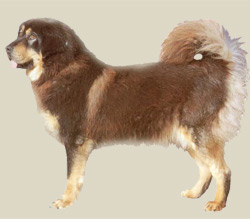
Country of Origin: Tibet
Group: Pinscher and Schnauzer - Molossoid Breeds - Swiss Mountain and Cattle Dogs
Section: Molossoid breeds
Original Function: guardian
Todays Function: guardian, companion
Dimension Male: 61-71 cm
Dimension Female: 61-71 cm
Weight Male: 64-78 kg
Weight Female: 64-78 kg
Litter Size: 3-10 puppies
Life span: 11-14 years
Other Names: Do-Khyi
Colors: Rich black, brown, gold and black/tan, grizzle, sable, blue/tan.
Living: Urban civilization, house within a fence, or on a farm. although used as guardians, they do not make
Recognized: CKC, FCI, KCGB, NKC, NZKC, APRI, ACR
Description
The Tibetan Mastiff is a powerful dog with a sturdy bone structure. It is a very large dog with a broad, massive head and a heavy, dense, medium-length coat. The bear-like head is wedged-shaped with a wide, blunt muzzle. The upper lip usually covers the lower lip. The nose is large and generally black. The teeth form a scissors or level bite. The v-shaped, thick-leathered ears hang down. Mature dogs, particularly males, tend to have moderate dewlap. The body is slightly longer than tall and the legs are heavy-boned and powerful. Marco Polo described it as "tall as a donkey with a voice as powerful as that of a lion." The muzzle is lighter than that of the English Mastiff, with an extremely strong jaw. Rear dewclaws should be removed, but front dewclaw removal is optional. The coat forms a heavy ruff around the neck. The hair on the head is short. The plumed tail curls over the back in Spitz fashion. The Tibetan Mastiff is usually black, sometimes with gold or tan markings, though he may also come in chocolate, blue & tan, sable, gold, cream, or red, with or without tan markings. Some also have white markings.
Temperament
As befitting their long past as a solitary sentry and protector, Tibetan Mastiffs are independent, strong willed, and territorial. They are aloof toward strangers but devoted to their family. Proper socialization is essential so that they will accept strangers and not become overly suspicious. They are gentle and patient with their children, but may guard their home against visiting children who may appear to be threatening the family children. They are generally good with other dogs and are rarely dog aggressive. (In Tibet, they were often kept with Lhasa Apsos.) Most Tibetan Mastiffs are good with other animals.
Excercise
The Tibetan Mastiff tends to be calm indoors and moderately active outside. A long daily leash walk along with access to an outdoor yard should meet its needs. When confined to even a large space, the breed can become bored, frustrated and destructive. In fact, young Tibetan Mastiffs are among dogdom"s most skilled demolition experts. Grooming consists of brushing a few times a week (daily during shedding), paying special attention to the longer hair of the britches, tail and ruff. Their weather-resistant coat allows them to be comfortable in cold temperatures and surprisingly comfortable in warm, dry climates, but they are not suited for hot, humid climates. Nor are they suited to living outside, as their temperament suffers unless they are integrated into the family. They like to bark loudly at night. Females have only one estrus each year.
Grooming
The Tibetan Mastiff should be brushed regularly. In the winter the coat has an abundance of very thick hair. The thick double coat sheds only once per year during a four week period in spring and/or summer. During this time it should be brushed and combed
Health
Major concerns: none
Minor concerns: CHD, hypothyroidism
Occasionally seen: entropion, seizures, canine inherited demyelinative neuropathy
Suggested tests: hip, thyroid
Click here to ORDER this PUPPY
